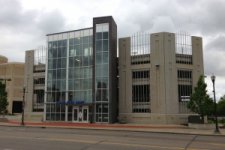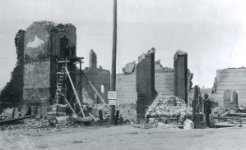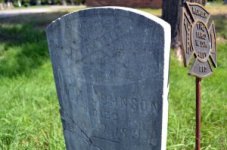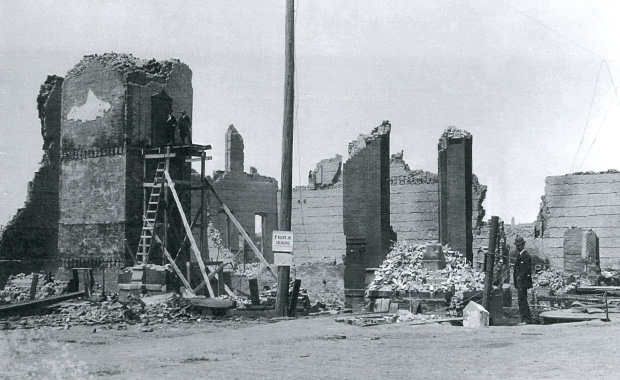The Great Fargo Fire of 1893
JUNE 5, 2013
TROY LARSON
June 7th, 1893 was a typical Wednesday in Fargo, sunny but windy. Fargo’s six thousand residents were going about their lives, carrying out their business from mostly wooden storefronts and traveling from place to place in horse drawn carriages and wagons.
Winds were gusting to 30 miles per hour that day. Even today, if you’ve spent any time in Fargo, you know these windy days all too well. Rarely though do we give much thought to the danger that comes with a dry, windy summer day.

The Island Park Ramp stands on the site of Herzman’s Dry Goods Store, alleged origin of the Fargo Fire of 1893.
Around 2:15 that June day, a fire broke out in the 500 block of Front Street, now known as Main Avenue. It was the beginning of an event that would come to be known as the Great Fargo Fire of 1893.
One account claims the fire started at the rear of Herzman’s Dry Goods Store which stood approximately where the Island Park parking ramp stands today. According to another account, the fire started when ashes were thrown from the rear of the Little Gem Restaurant, across the way from Herzman’s. Regardless of the source, the fire quickly spread out of control on that breezy Wednesday.
A firehouse was located on Front Street, right across from Herzman’s. They no doubt would have reacted quickly and extinguished the blaze before it got out of control, but in a tragic twist of fate, they were out hosing down Fargo’s dusty streets. It was a regular duty for the fire department in those days — an effort to keep the dirt from the unpaved streets from blowing all over town. The firehouse was empty.

Former site of Moody’s department store.
A neighboring gun store caught fire and the block was rocked when a powder keg exploded, intensifying the fire. Just down the block there was a fire alarm box in front of Moody’s Department store, where Bank of the West now stands. The key to the alarm box was kept in the Sundberg Jewelry Store, but the clerk on duty was unable to find it. It was the pre-telephone era, and this simple problem further delayed the fire fighting effort. The fire burned for forty-five minutes before the alarm was sounded, and by that time, it was too late.
In 1893, fire fighting technology was primitive and in a state of transition. Municipalities that could afford them had the newest technology — steam powered fire engines. More commonly, fire carts were horse drawn, or even hand-pulled to the scene of fires. Automotive fire engines were just on the horizon at the time.
Fargo native John Caron built a very informative Fargo history website which now resides with the North Dakota Institute for Regional Studies, and which contains a very nice accounting of the Fargo Fire. In the accompanying photos, you can see Fargo firefighters attempting to fight the fire with hoses stretched for blocks. Fighting fires in 1893 was a daunting task. Fire crews from outlying cities in both North Dakota and Minnesota rallied to the scene and attempted to aid in the battle, but their efforts though valiant, were fruitless.

The fire spread northwest, first jumping Front Street and proceeding north. It destroyed many of the buildings on the east side of Broadway, then eventually jumped across Broadway and burned all the way to the prairie on the west side of the city. The result was total devastation. 31 blocks of businesses were destroyed and over 350 buildings burned to ruin, including City Hall.
Firefighter W.H. Johnson reportedly died the following day as a result of smoke inhalation while fighting the fire, however his headstone puts his date of death at June 9th, two days after the fire. He is buried in Holy Cross Cemetery near Hector International Airport.

The headstone of W.H. Johnson at Holy Cross Cemetery
The rebirth of Fargo began almost immediately following the fire. In the ensuing days and months, local businessman Alexander Stern led an impressive effort to rebuild, and eventually replaced nearly 250 buildings, many in fire-resistant brick, at a cost of almost one million dollars. To prevent any future conflagration on the order of the 1893 fire, building codes and city regulations changed. The Fire Department was no longer expected to sprinkle the streets. The following year local businesswoman Ella J. Henderson was reprimanded by the city for laying wood sidewalks which had been outlawed following the fire. Upon discovery, the city removed them.
In 1895, Fargo held the first Fargo Fire Festival to celebrate the rebirth of the city, a celebration which was held annually until World War I. The final Fargo Fire Festival — a 40th anniversary event — was held in 1933.

 ghostsofnorthdakota.com
ghostsofnorthdakota.com
JUNE 5, 2013
TROY LARSON
June 7th, 1893 was a typical Wednesday in Fargo, sunny but windy. Fargo’s six thousand residents were going about their lives, carrying out their business from mostly wooden storefronts and traveling from place to place in horse drawn carriages and wagons.
Winds were gusting to 30 miles per hour that day. Even today, if you’ve spent any time in Fargo, you know these windy days all too well. Rarely though do we give much thought to the danger that comes with a dry, windy summer day.

The Island Park Ramp stands on the site of Herzman’s Dry Goods Store, alleged origin of the Fargo Fire of 1893.
Around 2:15 that June day, a fire broke out in the 500 block of Front Street, now known as Main Avenue. It was the beginning of an event that would come to be known as the Great Fargo Fire of 1893.
One account claims the fire started at the rear of Herzman’s Dry Goods Store which stood approximately where the Island Park parking ramp stands today. According to another account, the fire started when ashes were thrown from the rear of the Little Gem Restaurant, across the way from Herzman’s. Regardless of the source, the fire quickly spread out of control on that breezy Wednesday.
A firehouse was located on Front Street, right across from Herzman’s. They no doubt would have reacted quickly and extinguished the blaze before it got out of control, but in a tragic twist of fate, they were out hosing down Fargo’s dusty streets. It was a regular duty for the fire department in those days — an effort to keep the dirt from the unpaved streets from blowing all over town. The firehouse was empty.

Former site of Moody’s department store.
A neighboring gun store caught fire and the block was rocked when a powder keg exploded, intensifying the fire. Just down the block there was a fire alarm box in front of Moody’s Department store, where Bank of the West now stands. The key to the alarm box was kept in the Sundberg Jewelry Store, but the clerk on duty was unable to find it. It was the pre-telephone era, and this simple problem further delayed the fire fighting effort. The fire burned for forty-five minutes before the alarm was sounded, and by that time, it was too late.
In 1893, fire fighting technology was primitive and in a state of transition. Municipalities that could afford them had the newest technology — steam powered fire engines. More commonly, fire carts were horse drawn, or even hand-pulled to the scene of fires. Automotive fire engines were just on the horizon at the time.
Fargo native John Caron built a very informative Fargo history website which now resides with the North Dakota Institute for Regional Studies, and which contains a very nice accounting of the Fargo Fire. In the accompanying photos, you can see Fargo firefighters attempting to fight the fire with hoses stretched for blocks. Fighting fires in 1893 was a daunting task. Fire crews from outlying cities in both North Dakota and Minnesota rallied to the scene and attempted to aid in the battle, but their efforts though valiant, were fruitless.

The fire spread northwest, first jumping Front Street and proceeding north. It destroyed many of the buildings on the east side of Broadway, then eventually jumped across Broadway and burned all the way to the prairie on the west side of the city. The result was total devastation. 31 blocks of businesses were destroyed and over 350 buildings burned to ruin, including City Hall.
Firefighter W.H. Johnson reportedly died the following day as a result of smoke inhalation while fighting the fire, however his headstone puts his date of death at June 9th, two days after the fire. He is buried in Holy Cross Cemetery near Hector International Airport.

The headstone of W.H. Johnson at Holy Cross Cemetery
The rebirth of Fargo began almost immediately following the fire. In the ensuing days and months, local businessman Alexander Stern led an impressive effort to rebuild, and eventually replaced nearly 250 buildings, many in fire-resistant brick, at a cost of almost one million dollars. To prevent any future conflagration on the order of the 1893 fire, building codes and city regulations changed. The Fire Department was no longer expected to sprinkle the streets. The following year local businesswoman Ella J. Henderson was reprimanded by the city for laying wood sidewalks which had been outlawed following the fire. Upon discovery, the city removed them.
In 1895, Fargo held the first Fargo Fire Festival to celebrate the rebirth of the city, a celebration which was held annually until World War I. The final Fargo Fire Festival — a 40th anniversary event — was held in 1933.

The Great Fargo Fire of 1893
June 7th, 1893 was a typical Wednesday in Fargo, sunny but windy. Fargo’s six thousand residents were going about their lives, carrying out their business from mostly wooden storefronts…
 ghostsofnorthdakota.com
ghostsofnorthdakota.com
